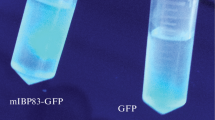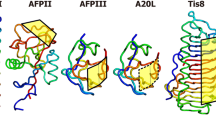Abstract
Ice-binding proteins are expressed in the cells of some cold adapted organisms, helping them to survive at extremely low temperatures. One of the problems in studying such proteins is the difficulty of their isolation and purification. For example, eight cysteine residues in the cfAF (antifreeze protein from the eastern spruce budworm Choristoneura fumiferana) form intermolecular bridges during the overexpression of this protein. This impedes the process of the protein purification dramatically. To overcome this issue, in this work, we designed a mutant form of the ice-binding protein cfAFP, which is much easier to isolate that the wild-type protein. The mutant form named mIBP83 did not lose the ability to bind to ice surface. Besides, observation of the processes of freezing and melting of ice in the presence of mIBP83 showed that this protein affects the process of ice melting, increasing its melting temperature, and does not decrease the water freezing temperature.











Similar content being viewed by others
Data Availability
The data presented in this study are available within the article.
References
Graether SP, Kuiper MJ, Gagné SM, Walker VK, Jia Z, Sykes BD, Davies PL (2000) β-Helix structure and ice-binding properties of a hyperactive antifreeze protein from an insect. Nature 406:325–328
Leinala EK, Davies PL, Jia Z (2002) Crystal structure of β-helical antifreeze protein points to a general ice binding model. Structure 10:619–627
Kuiper MJ, Morton CJ, Abraham SE, Gray-Weale A (2015) The biological function of an insect antifreeze protein simulated by molecular dynamics. Elife 4:14
Xu H, Perumal S, Zhao X, Du N, Liu X-Y, Jia Z, Lu JR (2008) Interfacial adsorption of antifreeze proteins: a neutron reflection study. Biophys J 94:4405–4413
Tyshenko MG, Doucet D, Davies PL, Walker VK (1997) The antifreeze potential of the spruce budworm thermal hysteresis protein. Nat Biotechnol 15:887–890
Doucet D, Tyshenko MG, Kuiper MJ, Graether SP, Sykes BD, Daugulis AJ, Davies PL, Walker VK (2000) Structure-function relationships in spruce budworm antifreeze protein revealed by isoform diversity. Eur J Biochem 267:6082–6088
Garcia-Arribas O, Mateo R, Tomczak MM, Davies PL, Mateu MG (2006) Thermodynamic stability of a cold-adapted protein, type III antifreeze protein, and energetic contribution of salt bridges. Protein Sci 16:227–238
Melnik TN, Povarnitsyna TV, Glukhov AS, Melnik BS (2012) Multi-state proteins: approach allowing experimental determination of the formation order of structure elements in the green fluorescent protein. PLoS ONE 7:e48604
Melnik BS, Molochkov NV, Prokhorov DA, Uversky VN, Kutyshenko VP (2011) Molecular mechanisms of the anomalous thermal aggregation of green fluorescent protein. Biochim Biophys Acta 1814:1930–1939
Glukhova KF, Marchenkov VV, Melnik TN, Melnik BS (2017) Isoforms of green fluorescent protein differ from each other in solvent molecules “trapped” inside this protein. J Biomol Struct Dyn 35:1215–1225
Fukuda H, Arai M, Kuwajima K (2000) Folding of green fluorescent protein and the cycle3 mutant. Biochemistry 39:12025–12032
Webb B, Sali A (2016) Comparative protein structure modeling using MODELLER. Curr Protoc Bioinforma 54:14
Pettersen EF, Goddard TD, Huang CC, Couch GS, Greenblatt DM, Meng EC, Ferrin TE (2004) UCSF Chimera?A visualization system for exploratory research and analysis. J Comput Chem 25:1605–1612
Van Der Spoel D, Lindahl E, Hess B, Groenhof G, Mark AE, Berendsen HJC (2005) GROMACS: Fast, flexible, and free. J Comput Chem 26:1701–1718
Bussi G, Donadio D, Parrinello M (2007) Canonical sampling through velocity rescaling. J Chem Phys 126:014101
Parrinello M, Rahman A (1981) Polymorphic transitions in single crystals: a new molecular dynamics method. J Appl Phys 52:7182–7190
Darden T, York D, Pedersen L (1993) Particle mesh Ewald: an N ⋅log( N ) method for Ewald sums in large systems. J Chem Phys 98:10089–10092
Hess B, Bekker H, Berendsen HJC, Fraaije JGEM (1997) LINCS: a linear constraint solver for molecular simulations. J Comput Chem 18:1463–1472
Yan J, Cheng J, Kurgan L, Uversky VN (2020) Structural and functional analysis of “non-smelly” proteins. Cell Mol Life Sci 77:2423–2440
Vacic V, Uversky VN, Dunker AK, Lonardi S (2007) Composition Profiler: a tool for discovery and visualization of amino acid composition differences. BMC Bioinform 8:211
Radivojac P, Iakoucheva LM, Oldfield CJ, Obradovic Z, Uversky VN, Dunker AK (2007) Intrinsic disorder and functional proteomics. Biophys J 92:1439–1456
Romero P, Obradovic Z, Li X, Garner EC, Brown CJ, Dunker AK (2001) Sequence complexity of disordered protein. Proteins 42:38–48
Williams RM, Obradovi Z, Mathura V, Braun W, Garner EC, Young J, Takayama S, Brown CJ, Dunker AK (2001) The protein non-folding problem: amino acid determinants of intrinsic order and disorder. Pac Symp Biocomput 14:89–100
Dunker AK, Lawson JD, Brown CJ, Williams RM, Romero P, Oh JS, Oldfield CJ, Campen AM, Ratliff CM, Hipps KW et al (2001) Intrinsically disordered protein. J Mol Graph Model 19:26–59
Mészáros B, Erdős G, Dosztányi Z (2018) IUPred2A: context-dependent prediction of protein disorder as a function of redox state and protein binding. Nucleic Acids Res 46:W329–W337
Acknowledgements
We are grateful to Alexei V. Finkelstein for fruitful discussions and Ekaterina N. Samatova for assistance.
Funding
This research was funded by Russian Science Foundation, grant number 21-14-00268.
Author information
Authors and Affiliations
Contributions
Conceptualization, BSM, VNU; methodology, BSM and VNU; investigation, DAA, ILS, KAG, YDO, BSM, VNU; writing—original draft preparation, BSM and VNU, YDO, DAA, KAG; writing—review and editing, BSM and VNU, YDO, KAG; funding acquisition, BSM All authors have read and agreed to the published version of the manuscript.
Corresponding author
Ethics declarations
Conflict of interest
The authors declare no conflict of interest. The funders had no role in the design of the study; in the collection, analyses, or interpretation of data; in the writing of the manuscript, or in the decision to publish the results.
Additional information
Publisher's Note
Springer Nature remains neutral with regard to jurisdictional claims in published maps and institutional affiliations.
Rights and permissions
About this article
Cite this article
Deeva, A.A., Glukhova, K.A., Isoyan, L.S. et al. Design and Analysis of a Mutant form of the Ice-Binding Protein from Choristoneura fumiferana. Protein J 41, 304–314 (2022). https://doi.org/10.1007/s10930-022-10049-6
Accepted:
Published:
Issue Date:
DOI: https://doi.org/10.1007/s10930-022-10049-6




